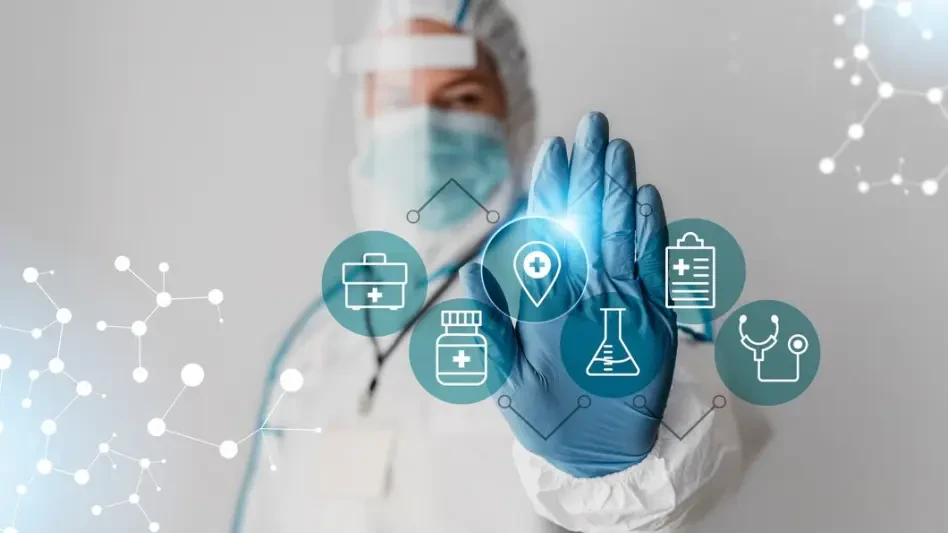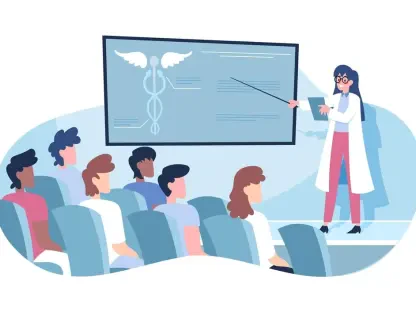Setting the Stage for a Healthcare Revolution
Imagine a world where a hospital can anticipate a patient’s risk of developing a life-threatening condition before any symptoms appear, allowing doctors to intervene with precision and save lives. This is not science fiction but the reality brought forth by predictive analytics, a transformative technology reshaping healthcare. With millions of patient records generated daily, the challenge lies in harnessing this data to not only react to illnesses but to prevent them. Predictive analytics offers a solution, using advanced algorithms to forecast health outcomes and optimize care delivery. This review delves into the mechanisms, applications, and implications of this cutting-edge tool, exploring how it stands as a beacon of hope for improving patient outcomes and operational efficiency in an overburdened healthcare system.
Unpacking the Technology: Features and Mechanisms
Data as the Foundation
At the heart of predictive analytics lies an intricate web of data sources that fuel its capabilities. Electronic health records, lab results, genetic profiles, and even lifestyle indicators such as diet or exercise habits form a comprehensive dataset. The integration of these diverse sources into a unified system is crucial, as fragmented or poor-quality data can skew predictions and lead to misguided decisions. Ensuring data accuracy and consistency remains a cornerstone, enabling healthcare providers to trust the insights generated and act on them with confidence.
Algorithms Driving Insights
The technical prowess of predictive analytics hinges on sophisticated machine learning algorithms designed to detect patterns and predict future events. Models such as logistic regression, decision trees, and neural networks analyze historical and real-time data to forecast outcomes like disease progression or hospital readmissions. Their performance is often measured through metrics like precision and recall, ensuring reliability in clinical settings. These algorithms adapt over time, learning from new data to refine their accuracy, making them indispensable for tackling complex health challenges.
Scalability and Adaptability
A standout feature of this technology is its scalability across diverse healthcare environments, from small clinics to sprawling hospital networks. Predictive analytics systems can be tailored to specific needs, whether for tracking infectious disease outbreaks or optimizing emergency room workflows. Their adaptability also extends to integrating with emerging tools like wearable devices, which provide continuous patient data. This flexibility ensures that the technology remains relevant as healthcare demands evolve, offering a robust framework for innovation.
Performance in Real-World Healthcare Settings
Enhancing Clinical Outcomes
In practical applications, predictive analytics has demonstrated remarkable potential in transforming patient care. By identifying early warning signs of conditions like sepsis or heart failure through subtle data trends, it enables timely interventions that can prevent severe complications. Hospitals employing these tools report improved diagnosis rates, as risk stratification models prioritize patients needing urgent attention. This proactive approach marks a significant shift from traditional reactive care, directly impacting survival rates and patient well-being.
Optimizing Operational Efficiency
Beyond clinical benefits, the technology excels in streamlining healthcare operations. Predictive models forecast patient admission spikes, allowing facilities to allocate staff and resources effectively. Supply chain management also sees gains, with hospitals avoiding overstocking or shortages of critical supplies like medications. Such efficiency not only reduces costs but also ensures that care delivery remains uninterrupted, a vital factor in high-pressure environments like intensive care units.
Case Studies of Impact
Real-world examples underscore the tangible impact of predictive analytics. In certain urban hospitals, algorithms predicting patient no-shows have improved appointment scheduling, reducing wait times and enhancing access to care. Another instance involves rural clinics using risk assessment tools to identify high-risk populations for chronic diseases, enabling targeted outreach programs. These cases highlight how the technology bridges gaps in care delivery, offering solutions tailored to specific community needs and operational constraints.
Challenges Hindering Broader Adoption
Privacy and Security Concerns
Despite its promise, predictive analytics faces significant hurdles, particularly around patient privacy and data security. The vast amounts of sensitive information processed raise risks of breaches or misuse, necessitating stringent safeguards. Compliance with regulations like HIPAA is non-negotiable, yet breaches still occur, eroding trust among patients and providers. Addressing these concerns through robust encryption and transparent data practices is essential for sustained adoption.
Bias and Equity Issues
Another critical challenge lies in algorithmic bias, which can perpetuate disparities in healthcare outcomes. If training data lacks diversity, predictions may favor certain demographics over others, leading to inequitable treatment plans. Efforts to include representative datasets and regularly audit algorithms for fairness are underway, but gaps remain. Ensuring equity in predictive tools is not just a technical issue but a moral imperative to guarantee fair care for all.
Integration and Trust Barriers
Integrating predictive analytics into existing healthcare systems poses logistical difficulties, often requiring substantial investment in infrastructure and training. Resistance from staff, stemming from unfamiliarity or skepticism about machine-driven insights, further complicates adoption. Building trust through transparent communication about how predictions are made and involving clinicians in tool development can mitigate these barriers, fostering a collaborative environment where technology supports human expertise.
Reflecting on the Journey and Looking Ahead
Having explored the intricacies of predictive analytics in healthcare, it becomes evident that this technology has carved a path toward transformative change, balancing remarkable benefits with notable challenges. Its ability to enhance clinical decision-making and streamline operations stands out as a game-changer, while real-world applications showcase measurable improvements in patient care. Yet, hurdles like privacy risks and bias demand attention, underscoring the need for vigilance in implementation.
Moving forward, stakeholders must prioritize actionable steps to maximize the potential of predictive analytics. Investing in secure data frameworks and diverse training datasets can address privacy and equity concerns, ensuring trust and fairness. Additionally, fostering partnerships between technologists and healthcare professionals will ease integration, aligning tools with clinical workflows. As advancements in artificial intelligence continue to refine predictive models over the next few years, a focus on accessibility could democratize these benefits, reaching underserved communities. Ultimately, the journey ahead calls for a commitment to ethical innovation, ensuring that predictive analytics evolves as a force for inclusive, patient-centered care.









